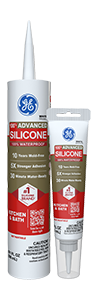Note: This DIY article is provided as a general guide only and is not intended to take the place of product-specific installation procedures; always follow applicable manufacturers’ instructions. Depending on your home’s age and condition, location within the home, and other potential factors, repairs and/or upgrades or other services may be necessary prior to the beginning and/or completion of your project that may involve the services of a home improvement professional. This article does not include advice pertaining to local building codes and/or any related inspections.
A sharp-looking finish isn’t just about the tile, trim, or paint. It’s also in the lines that hold it all together. With the right colored sealant, you can keep water and drafts out while keeping the look clean, deliberate, and seamless. Whether you’re working in the kitchen, bathroom, or around the exterior, the right match makes the whole job feel finished.
Why color matters
A sealant line might be small, but it shapes how a space looks—and how it holds up. When the color clashes, it pulls the eye and interrupts the finish. Even a tight job can look unfinished. But when the sealant blends into the surface, it disappears into the design. What’s left is a space that feels built-in, not patched in.
Color also keeps the focus on the surface—not the seam. All materials expand and contract with time and temperature. That natural flex can show as fine shifts in the sealant line, especially when the contrast is high. A close color match helps those lines stay visually quiet, so the space looks stable and intentional—even when it’s moving as it should.
In wet areas, a good color match keeps the seal looking fresh longer. White or clear beads can show surface wear—like water marks or mildew stains—even when the sealant is still doing its job. With the right colored sealant, you get the same waterproof protection, but the finish holds its clean look through daily use.
Where to use colored sealants in your home
The right sealant color can sharpen your finish or help it disappear completely. That kind of control makes a difference in every room—especially where surfaces meet water, heat, and movement. Here’s how to put colored sealants to work where it matters most.
Kitchen backsplashes & countertops
Grease, water, and crumbs don’t stand a chance when the sealant line is tight—and disappears into the backsplash. Almond-colored sealants blend into warm-toned grout, tile, or cabinetry. Clear works well against stone or glass. Either way, you get a clean seal that looks like part of the design, not a quick fix.
- Use: Supreme Silicone Kitchen & Bath Sealant
- Colors available: white, clear, almond
Bathrooms – tubs, sinks, glass, and tile
Showers and sinks push sealants to their limit. With the right colored sealant match, the bead fades into tile, marble, or glass—and stays mold-free while it does. Almond tones keep warm tile looking seamless. Clear keeps the focus on the finish, not the line.
- Use: Advanced Silicone 2® Kitchen & Bath Sealant
- Colors available: white, clear, almond
Trim, doors, and interior joints
White trim is easy. But darker finishes? That’s where light gray, black, or brown sealants shine. A matched line around baseboards or door frames blends in and avoids that white-bead pop you notice from across the room. For interior or exterior trim, a pre-colored silicone gives you long-term flexibility, clean adhesion, and no need for paint.
- Use: Advanced Silicone 2® Window & Door Sealant
- Colors available: white, clear, almond, black, light gray, brown
Colored sealants don’t just hide gaps—they complete the look. GE’s 100% silicone options flex with your home and resist mold, rain, and UV damage.
Using colored sealants for outdoor style and year-round strength
Outside, sealants take more punishment—sun, rain, freeze, flex. That’s where silicone sealant earns its keep. With the right match, you can protect exposed joints without breaking the look of your siding, concrete, or trim. And because some GE formulas come in purpose-matched tones like light gray, you don’t have to settle for bright white on weathered concrete or dark metal.
Patios, driveways, and stone joints
Concrete Silicone Sealant comes in light gray to blend with masonry, stone, or mortar. It holds its shape across wide joints and rough substrates—perfect for expansion lines that flex in heat and frost.
Roof flashing, vents, and steel trim
For metal surfaces, Metal Silicone Sealant offers a clean metallic gray finish that blends into high-end siding or roof panels. It resists corrosion, doesn’t discolor, and flexes with panel movement year-round.
For gutters and downspouts, GE offers clear sealants that visually disappear, but they aren’t color-matched. If the goal is a fully blended aesthetic, focus on matched tones for trim and metalwork instead.
Choosing the right sealant—what works where
Not all sealants are built for the same job—and not every job needs the same finish. Whether you’re sealing a tub edge, a stone joint, or a painted baseboard, knowing what type of sealant to use is just as important as choosing the right color. Here’s how GE’s formulas break down by chemistry and use.
- What it does well: waterproof, mold-resistant, permanently flexible
- What to watch for: not paintable
- Best for: wet areas, outdoor joints, siding, tubs, showers, stone, or concrete
SMP hybrid (paintable silicone)
- What it does well: paintable, fast-curing, flexible
- What to watch for: slightly less UV-resistant than pure silicone
- Best for: painted trim, crown molding, and interior detail work where color matching matters
- What it does well: budget-friendly, paintable, easy to tool
- What to watch for: not fully waterproof; may shrink or crack over time
- Best for: dry interior joints, low-moisture areas like baseboards and door casings
When to use a colored sealant vs. a paintable sealant
Use a colored silicone sealant when:
- You want the sealant to match tile, metal, siding, or trim
- You don’t plan to paint over it
- You need long-term color stability and UV resistance
- You’re sealing kitchens, baths, exteriors, or masonry
Use a paintable hybrid sealant when:
- The surface will be painted after sealing (e.g., baseboards, molding)
- You need to match a specific or custom wall color
- You want more visual flexibility
- You’re working indoors in low-moisture areas
Application tips for the cleanest finish
Colored sealants offer a cleaner finish—but only if the application is just as sharp. When the sealant is visible by design, every detail matters: surface prep, tooling, and even how the tube is stored can affect the final look.
Here’s how to keep your lines clean and your color consistent:
- Avoid surface dust and residue: On dark or tinted sealants, even a thin layer of soap scum or leftover caulk can dull the finish. Clean thoroughly—and if you’re removing old sealant, use a plastic tool that won’t damage the surface, like the GE Sealant Remover Tool.
- Use painter’s tape for dark joints: Colored beads show every edge. Mask the area to keep borders sharp, especially when sealing against black, gray, or brown trim or tile. Peel the tape before the sealant skins.
- Don’t drag your finish: Use a gloved finger or the GE Smoothing Tool to shape the bead cleanly. Avoid overworking the line, especially with pigmented or metallic-toned sealants.
- Keep color batches consistent: For large projects, use the same production lot when possible. Slight color variations can happen between batches, even in factory-tinted silicone sealants.
- Store tubes tip-down: If you’re using the same tube across multiple rooms or days, cap it tightly and store it nozzle-down. That helps preserve color consistency and flow.
Colored sealants FAQ
Do colored sealants fade or yellow over time?
Not if you’re using a 100% silicone sealant. GE’s colored formulas resist UV exposure, heat, and moisture—so the color stays true, even in outdoor or high-humidity areas.
Can I use colored sealants in bathrooms or kitchens?
Yes—as long as they’re waterproof and mold-resistant. Look for 100% silicone formulas made for wet areas. GE’s Kitchen & Bath sealants in almond or clear are ideal for showers, sinks, and backsplashes.
Can I paint over a colored sealant?
Only if it’s labeled paintable. GE’s hybrid formulas—like GE Paintable Silicone Supreme Window & Door Sealant—are made for painting after cure. Standard silicone sealants (even colored ones) are not paintable.
What if I need a color match that’s not available?
Go with a paintable hybrid if you need full color control. Apply the sealant, let it cure completely, and then paint it to match your trim or wall.
Ready to match your sealant to your style—and make it last? Find a store near you in the U.S. or Canada to shop GE’s line of colored silicone sealants—built for long-term protection that blends right in.

